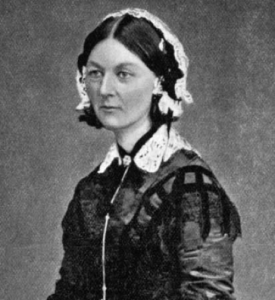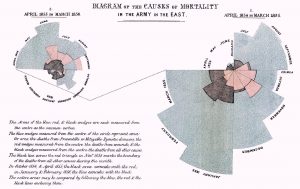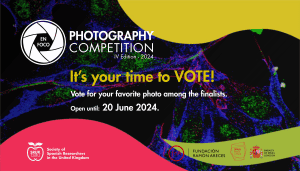In these days, the health crisis caused by the COVID-19 outbreak has forced most Europeans into a stay at home quarantine. Nevertheless, daily gestures of gratitude have emerged to acknowledge the efforts of one of the professional bodies that has been working tirelessly to stop the spread of the disease and reduce the amount of deceased. I am talking about health professionals, specially nurses, who suffer long and stressful work days while risking their own lives to take care of ourselves and our loved ones. For that reason, I would like to use this post to highlight and acknowledge their work not only because of their wonderful response to the current situation, but also for all the times throughout the history that they have been there when our health has gone down hill. Therefore, I find it is a good time to commemorate the woman considered to be “the mother of modern nursing”: Florence Nightingale. Thanks to her, hospitals and health centres started to impose basic hygienic measures such as hand washing, and professional nursing began with the creation of the first non-religious Nursing schools. In addition, she was a feminist with strong beliefs, even before the suffragette movement emerged, who promoted and claimed equal opportunities for nurses as health professionals.

Figure 1. Portrait of Florence Nightingale.
Nightingale (12th May 1820 – 13th August 1910) was born and raised in a wealthy British family. Since she was very young, she felt the need to dedicate her life to take care of sick people. Strongly focused on making her dream come true, Nightingale studied Science and Maths, defying the opposition of her family and the strict social conventions of Victorian society, which had marriage as the only decent future for women. For some years, she travelled all over the UK and other countries where she visited health institutions to complete her professional training.
Her most famous and important contribution, however, arrived when she was designated by the British Army to lead a group of 38 voluntary nurses in the Crimean War (1853-1856). In the field hospitals, infectious diseases and horrible hygienic conditions killed more soldiers than battles themselves (i.e., 80 out of 100 deaths). To overcome this painful situation, Nightingale established basic hygienic measures that led to a significant decrease in mortality, as shown in the Rose Diagram (see Fig. 3). The Rose Diagram, known as polar diagram in Mathematics, was invented by herself as a system to keep track of the number of deaths and their causes every month. One of the hygienic measures, by the way, was something that we now listen many times per day as one of the most effective and simple ways to avoid coronavirus infection: hand washing. Thanks to Nightingale and her work in Crimean War, hygiene became essential to save lives.

Figure 2. Crimean War Memorial.
Back in the UK, where she was received as a war heroin, she started a campaign to improve the quality of hygiene and assistance in hospitals. Shortly after, she funded the first official School of Nursing at Saint Thomas’ Hospital in London, where she implemented novel and important health reforms in all type of health institutions throughout the British Empire. It is important to note that these developments were mainly based on the detailed statistical and epidemiological reports that Nightingale periodically wrote for the Government. Her work as statistician is probably less well known, although she is considered to be a pioneer in the use of descriptive statistics and epidemiological methods in public health. She received several awards and distinctions thanks to her innovative way of analyzing the data and present the results in a visual and clear manner, such as being the first woman to be part of the British Statistical Society in 1858. Besides, in 1874 she was an honorary member of the American Statistical Society, and the Queen Victory awarded her with The Order of Merit. If we take into account the strict social and moral rules concerning women during the Victorian era in the UK, these distinctions and awards granted to Nightingale become even more valuable.
Currently, we are getting used to see the application of this type of evolutionary methods described and/or pictured in all types of media, mostly via social media. Specifically, I am referring to the statistical graphs that show the evolution and spread of SARS-CoV-2, the virus responsible for the COVID-19, across the world; which are updated as more data are available. Generating these visual graphs is possible thanks to the continuous collaboration between scientific researchers and health professionals, who are working together to gain a better insight into how the virus evolves and how we can stop it. And thinking that the first visual graphs were drawn by Nightingale in the previous century, without the technological advances that we have, to show the authorities the importance of implementing health reforms… she was indeed a pioneer in health emergency teams!

Figure 3. The Rose Diagram created by Florence Nightingale. The different types of monthly deaths are identified with different colours (gun wounds, infections, and other causes), so it is easier to infer the mortality rate with just a quick glance.
Florence Nightingale is nowadays a reference for any nurse, student or professional. The Nightingale Pledge, a modification of the Hippocratic Oath, is still recited by nurses at their pinning ceremony at the end of their training. We are currently expressing our deep gratitude towards this professional body, but we must not forget them once this health crisis is overcome. Nurses are anonymous daily heroes and heroins, and we must take care of them as well as respect and acknowledge their work, so they can carry on taking care of us once we have defeated the coronavirus. Thanks from the bottom or our heart.
* * *
By Olaya Muñoz Azcárate (@OlayinaBio), PhD in Biology. Project manager for agrifood sector. Up Intelligence. Gijón (Spain)
More information:
- Biography of Florence Nightingale. Source: Wikipedia.
- Biography of Florence Nightingale. Source (Spanish): Estadística para todos.
- Post about Florence Nightingale being a pioneer in statistics. Source (Spanish): Mujeres con Ciencia.
- Post about Florence Nightingale highlighting her role as a nurse and her contribution to statistics. Source (Spanish): Mujeres con Ciencia.
- Post about Florence Nightingale. Source (Spanish) : ELSEVIER.






